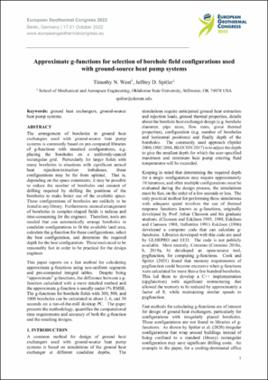| dc.contributor.author | Spitler, Jeffrey D. | |
| dc.contributor.author | West, Timothy N. | |
| dc.date.accessioned | 2022-11-07T14:32:04Z | |
| dc.date.available | 2022-11-07T14:32:04Z | |
| dc.date.issued | 2022-10-17 | |
| dc.identifier.citation | Spitler, J. & West, Timothy N. (2022). Approximate g-functions for selection of borehole field configurations used with ground-source heat pump systems. | |
| dc.identifier.uri | https://hdl.handle.net/11244/336597 | |
| dc.description.abstract | The arrangement of boreholes in ground heat exchangers used with ground-source heat pump systems is commonly based on pre-computed libraries of g-functions with standard configurations, e.g. placing the boreholes on a uniformly-spaced rectangular grid. Particularly for larger fields with many boreholes in situations with significant annual heat rejection/extraction imbalance, these configurations may be far from optimal. That is, depending on the space constraints, it may be possible to reduce the number of boreholes and amount of drilling required by shifting the positions of the boreholes to make better use of the available space. These configurations of boreholes are unlikely to be found in any library. Furthermore, manual arrangement of boreholes in complex-shaped fields is tedious and time-consuming for the engineer. Therefore, tools are needed that can automatically arrange boreholes in candidate configurations to fit the available land area, calculate the g-function for these configurations, select the best configuration, and determine the required depth for the best configuration. These tools need to be reasonably fast in order to be practical for the design engineer.
This paper reports on a fast method for calculating approximate g-functions using non-uniform segments and pre-computed integral tables. Despite being “approximate” g-functions, the difference between a g-function calculated with a more detailed method and the approximate g-function is usually under 1% RMSE. The g-functions for borehole fields with 300, 500, and 1000 boreholes can be calculated in about 2, 6, and 30 seconds on a run-of-the-mill desktop PC. The paper presents the methodology, quantifies the computational time requirements and accuracy of both the g-function and the resulting designs. | |
| dc.format | application/pdf | |
| dc.rights | This material has been previously published. In the Oklahoma State University Library's institutional repository this version is made available through the open access principles and the terms of agreement/consent between the author(s) and the publisher. The permission policy on the use, reproduction or distribution of the material falls under fair use for educational, scholarship, and research purposes. Contact Digital Resources and Discovery Services at lib-dls@okstate.edu or 405-744-9161 for further information. | |
| dc.title | Approximate g-functions for selection of borehole field configurations used with ground-source heat pump systems | |
| dc.date.updated | 2022-10-29T13:27:31Z | |
| dc.description.department | Mechanical and Aerospace Engineering | |
| dc.type.genre | Conference proceedings | |
| dc.type.material | Text | |
| dc.subject.keywords | ground heat exchangers, ground-source heat pump systems | |
| dc.identifier.author | ORCID: 0000-0003-0826-0512 (Spitler, Jeffrey) | |
| dc.identifier.author | ScopusID: 7004014855 (Spitler, Jeffrey) | |
